Software testing is a crucial aspect of the development process, ensuring that applications function as expected and meet user requirements. Among the various testing methods, such as Smoke Tests, Sanity Tests, and Subset Regression Testing, the differences between these methods are essential for the Development Team and Testing Team to understand. Manual Testing 📝, Detailed Testing 🔍, and the use of Automation Tools 🤖 are all part of the comprehensive Testing Process.
Smoke Testing and Sanity Testing play different roles in software testing, alongside other testing types like Subset Acceptance Testing and Exhaustive Testing.
Understanding the Key Differences ⚖️ between these two types of testing is essential for effective quality assurance. This article will cover Smoke Testing and Sanity Testing including what they are, why they're used, how they're done, and how they differ.
📌 Differences Between Smoke Testing & Sanity Testing: Understand the crucial distinctions between these two types of testing for effective software quality assurance.
📌 What is Smoke Testing? Learn about Smoke Testing (Build Verification Testing), its purpose, process, and examples, such as verifying a web application's basic functionality and stability.
📌 Main purpose of Smoke Testing: Discover how Smoke Testing ensures critical functionalities work correctly, identifies major issues early, and prepares builds for comprehensive testing.
📌 What is Sanity Testing? Explore Sanity Testing's role in verifying specific functionalities after minor changes or bug fixes, focusing on integration and core function verification.
📌 Sanity Testing Examples: See practical examples of Sanity Testing in action, such as bug fix verification and new feature validation.
What is Smoke Testing ?
Smoke Testing, also known as "Build Verification Testing," is a preliminary testing phase designed to check the basic functionality of an application. The term "smoke test" originated from hardware testing, where a device would be powered on for the first time and checked for smoke as a sign of severe issues.
Smoke Testing helps determine if a build is stable enough for more testing. It helps to identify basic Issues 🛠️ and broader Issues 🌐 early on, utilizing tools such as an Open-Source Tool or an Automation Tool 🤖.
By conducting Frequent Builds 🔄, teams can ensure that Critical Features 🚀 and Essential Features 💡 are functioning correctly. This phase often includes tests like User Creation 👤, API Testing, and performing a Sanity Check. The Execution Process ⏳ of smoke tests helps catch Regression Bugs and verify that the Basic Function 🔧 of the application is intact.
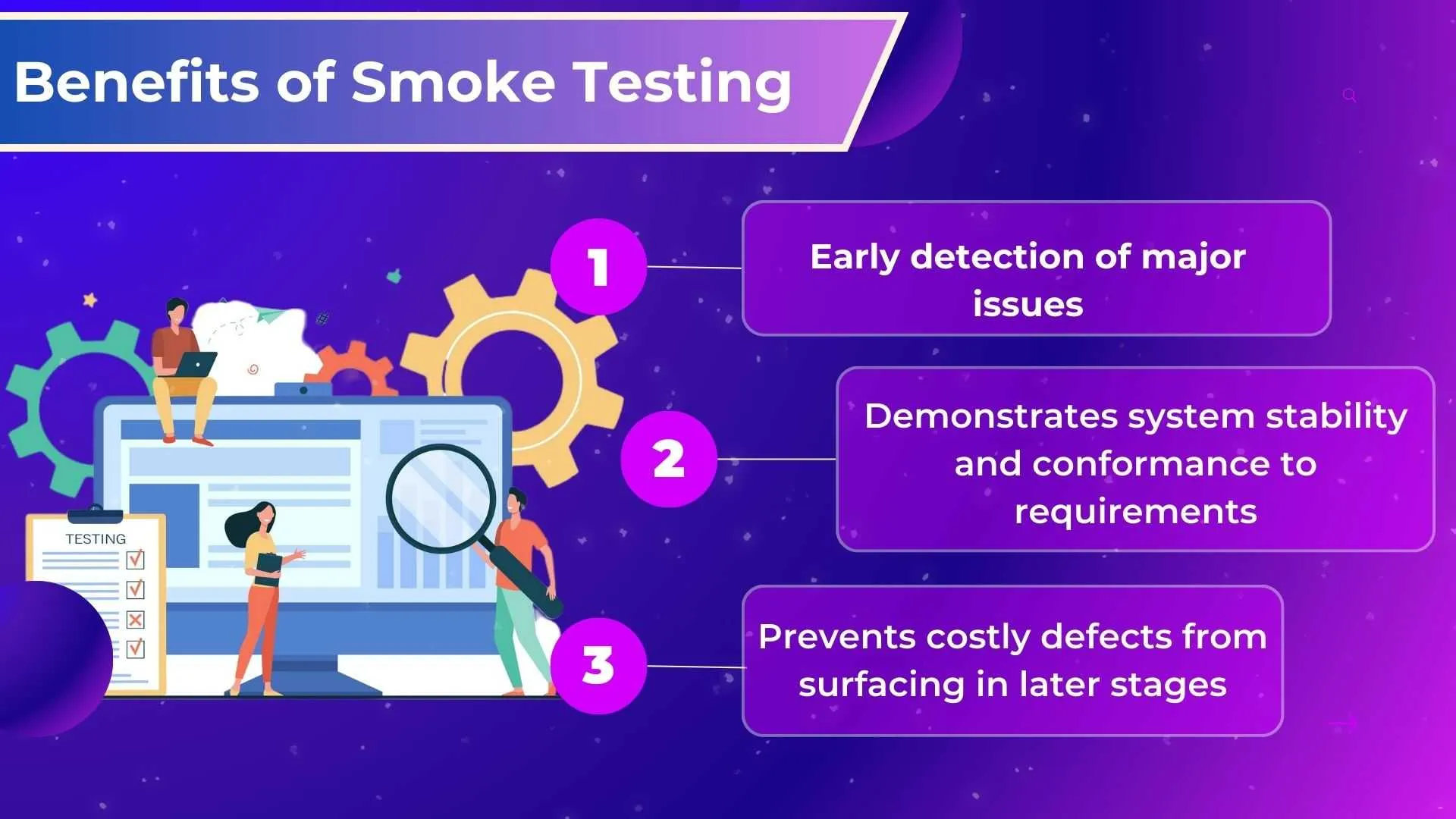
The Main Purpose of Smoke Testing
The main purpose of Smoke Testing is to verify that critical functionalities are working correctly. 🧪 However, it doesn't cover all functionalities, unlike more exhaustive tests. Instead, it focuses on ensuring the build is stable enough for further, more detailed testing. It helps in identifying major issues early in the Development Cycle 🔄, saving time and resources. 🚀 While it provides a quick check of the essential features, it does not delve into every aspect of the application, leaving comprehensive testing for later stages.
Testing Efforts 🛠️ include Automated Smoke Tests 🤖 and Manual Tests to verify Application Functions 📱. If a build passes the Smoke Test Suite ✅, it is deemed stable enough for more exhaustive testing, including Integration Tests 🔗, Verification Testing 🔍, and User Acceptance Testing.
The Execution Of Smoke Tests ⏳ is a crucial Testing Phase that sets the stage for further Testing Methods 🔧 and ensures that the build is ready for comprehensive evaluation.

How does Smoke Testing work?
Smoke Testing involves executing a suite of basic tests to ensure that the critical functionalities of a software application are working correctly. It is often the first test run on a new build to check for fundamental issues before more rigorous testing begins. For large projects, 🤖 automated scripts are frequently used to perform Smoke Testing efficiently.
These scripts are designed to quickly execute the core functionalities of the application, such as launching the program, navigating through key interfaces, and performing basic operations. Automated Smoke Tests help save time and resources by providing rapid feedback on the build stability, allowing development teams to identify and address major issues early in the software development lifecycle.
It is typically performed manually or through automated scripts. The process involves executing a set of test cases that cover the most Critical Functionalities and Core functionalities of the application. These test cases are not exhaustive but are sufficient to verify the application's stability. This provides rapid feedback on building stability, helping teams identify major issues early. 🚀
- Identify Critical Functions 🛠️: Determine the Essential Features and Basic Functionalities that need to be tested.
- Create Test Cases 📝: Develop test cases that cover these critical areas, focusing on Functional Testing to ensure the Core Functionality is intact.
- Execute Test Cases ▶️: Run the test cases on the Initial Builds of the Software Product to ensure stability.
- Analyze Results 🔍: After a Smoke Test, review results to ensure all critical functionalities work properly. If passed, proceed to rigorous testing methods like Depth Testing, Integration Testing, and Regression Tests.
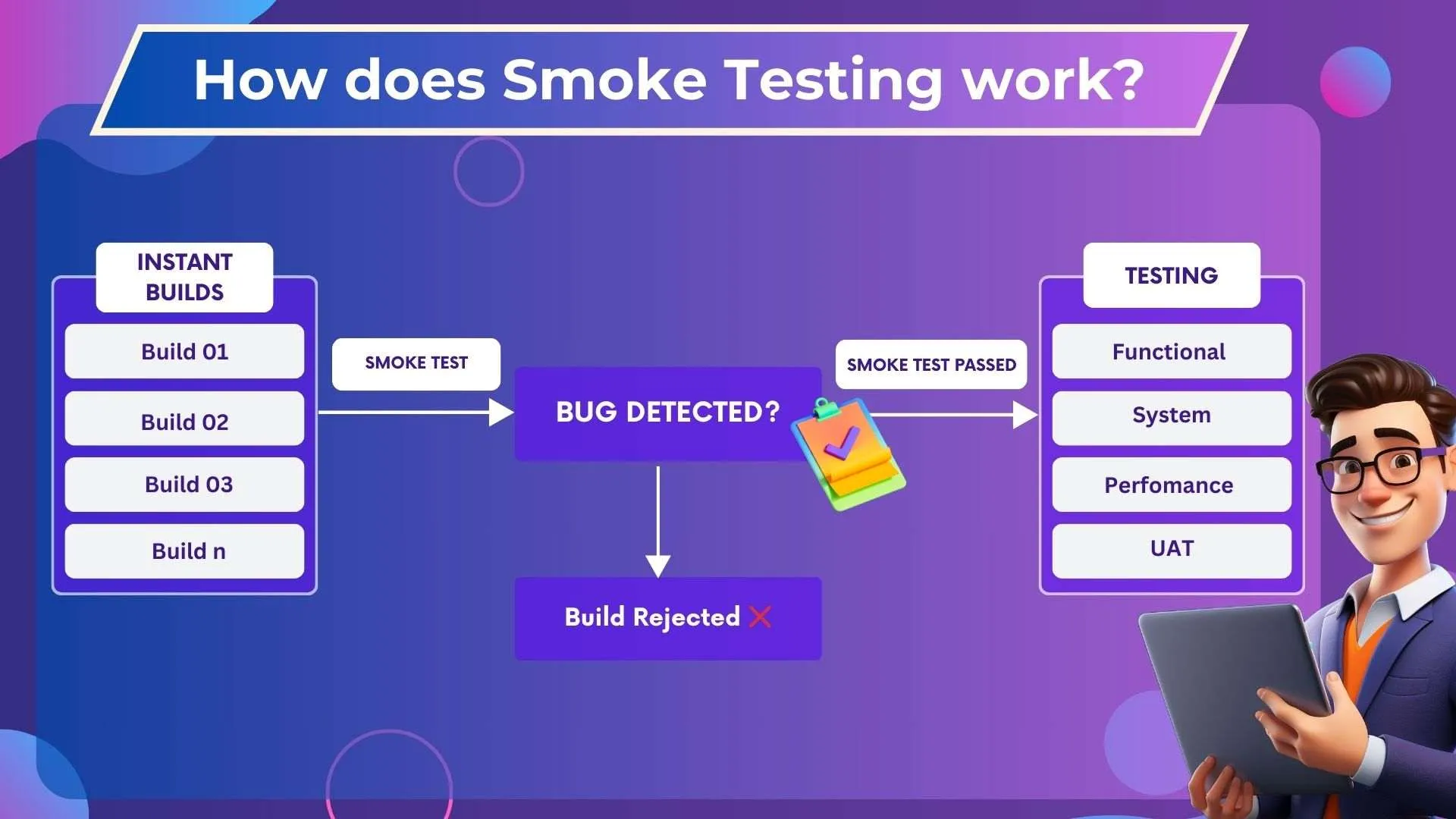
Examples of Smoke Testing in Software Testing
Smoke Testing helps in catching severe issues early, thereby saving time and resources in the development process. It is a Powerful Tool 🛠️ in the Quality Assurance process and is often performed in a staging environment before releasing to production. Here are some examples of Smoke Testing in Software Projects:
- Web Application 🌐: For a web application, smoke tests may include verifying that the application loads correctly, the home page is displayed, and the user can log in. These tests ensure the Key Features are operational.
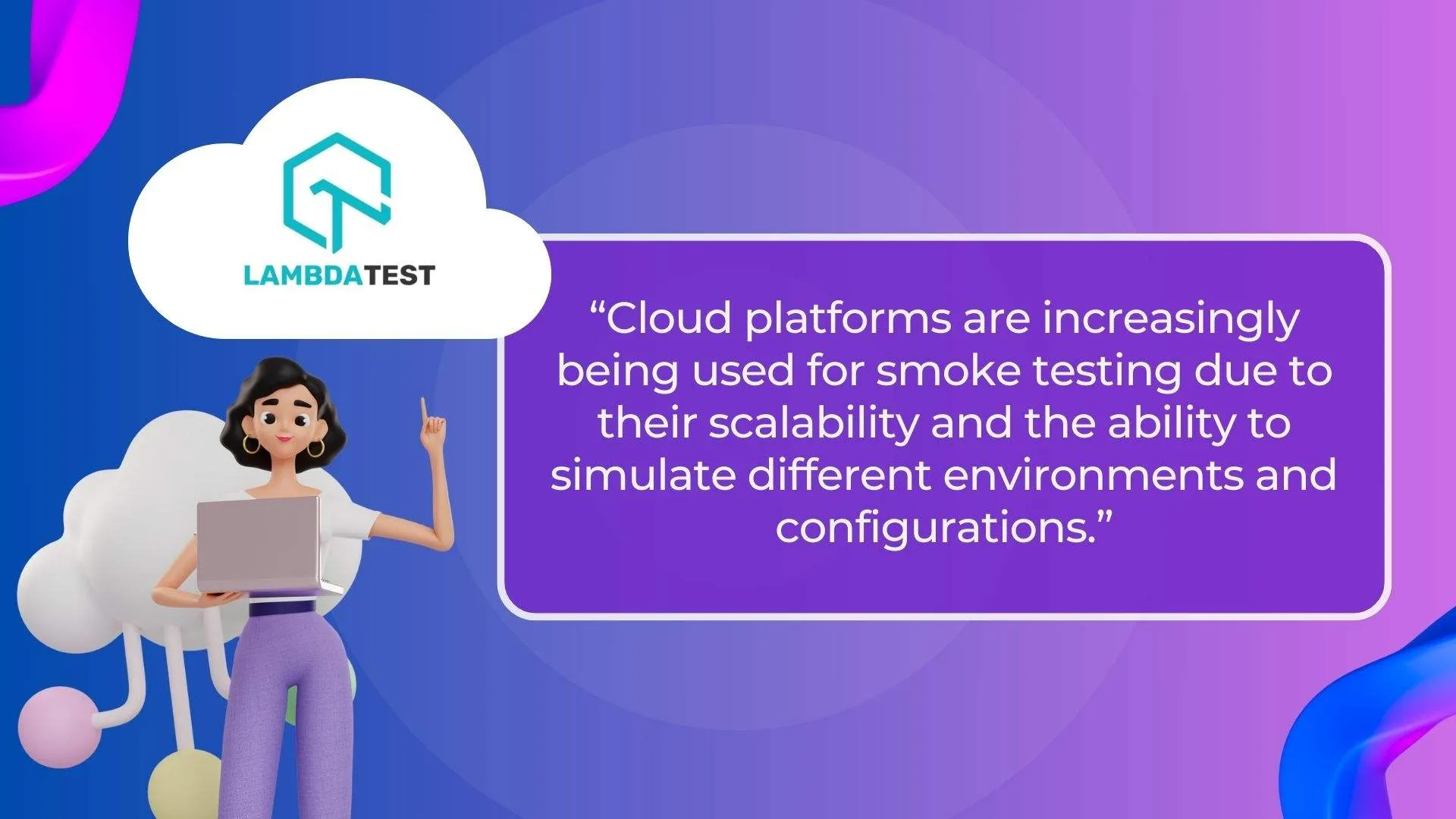
- Mobile App 📱: For a mobile application, smoke tests could ensure that the app opens without crashing, basic navigation works and key features like search and user profile access are functional.
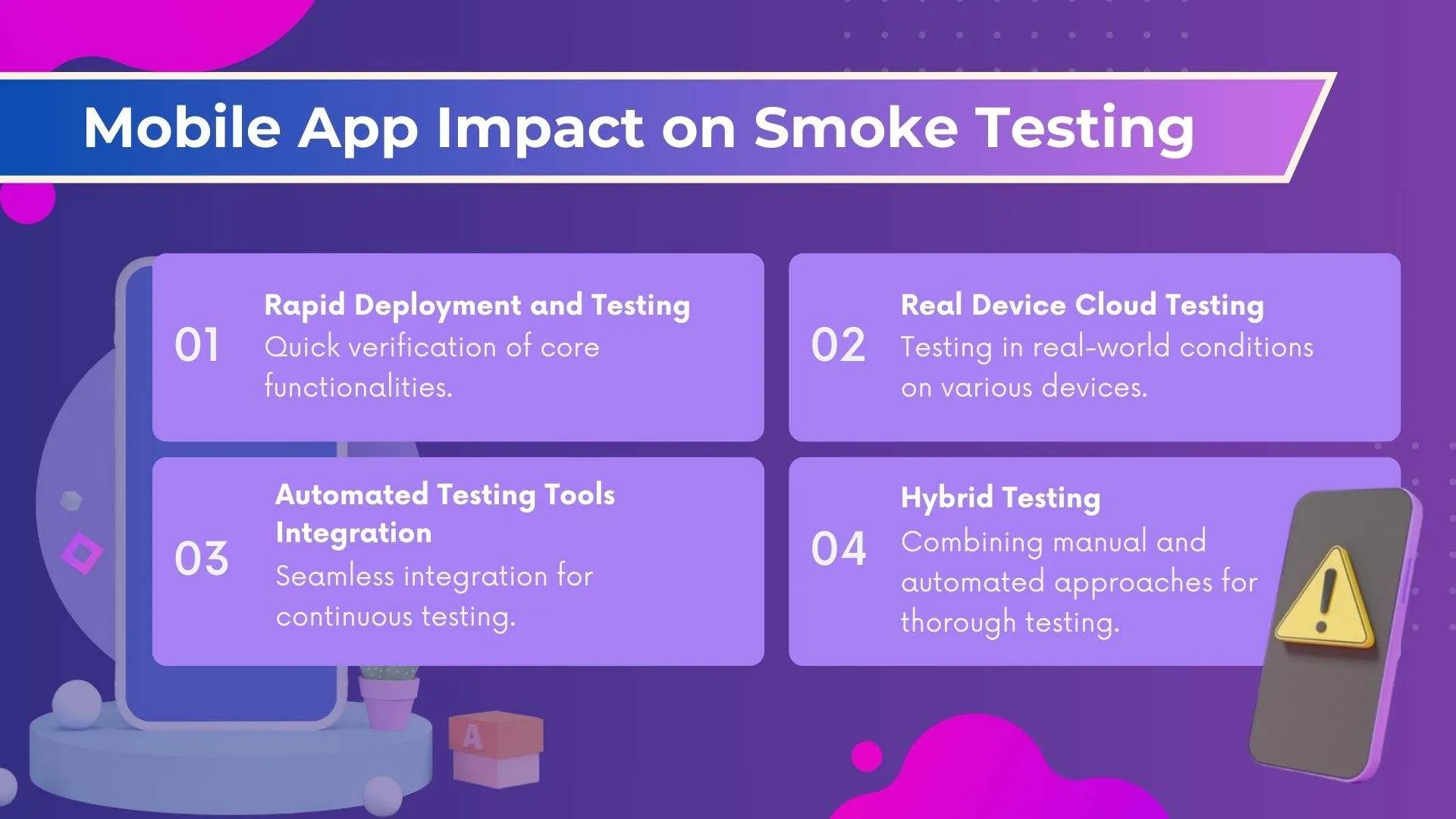
- APIs 🔗: When testing APIs, smoke tests would involve making sure that the API endpoints are reachable, and that they respond correctly to basic GET and POST requests.
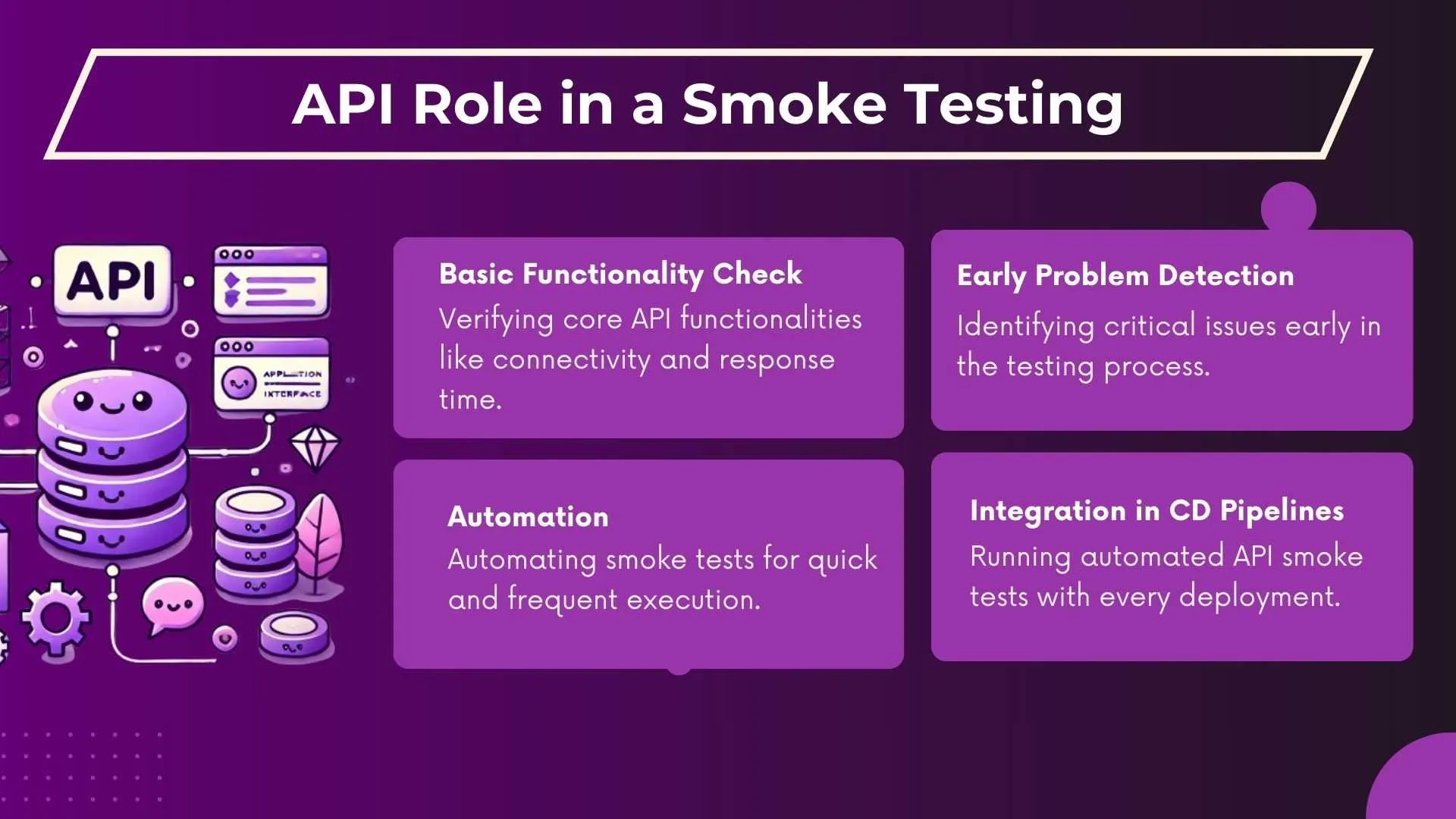
- Software Build 💻: After a new build, smoke tests might include checking that the application installs without errors, launches, and connects to the database successfully. This minimizes Testing Time and prepares the build for Additional Testing phases.

- E-commerce Platform 🛒: In an e-commerce application, smoke tests might check if the user can browse products, add items to the cart, and initiate the checkout process. This involves testing the Executable Programs to ensure core functionalities work.
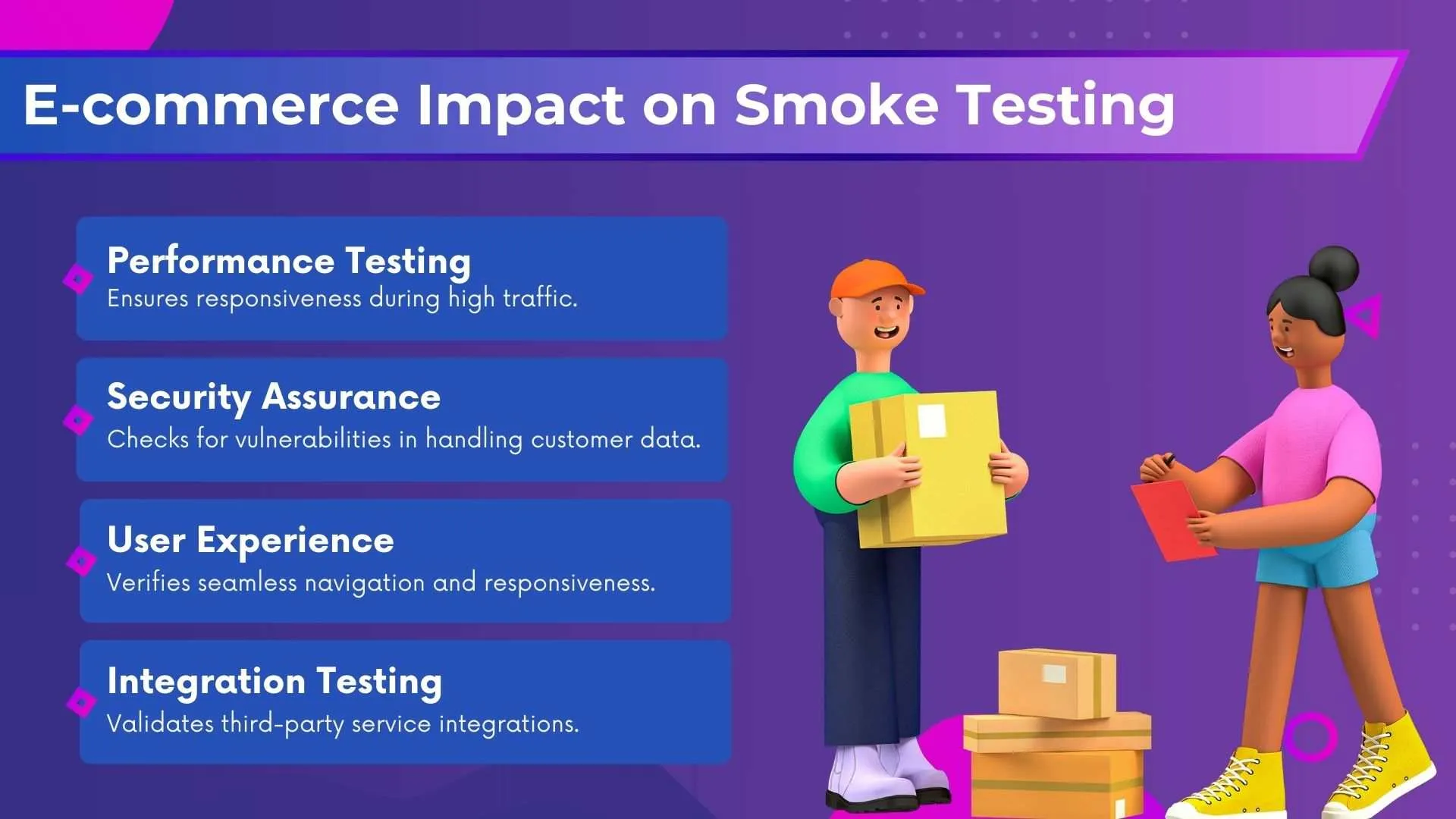
Smoke testing is done to make sure the main features of the application are working properly. Following Unit testing, Smoke Testing validates that the build is stable enough for Functional Testing and other Testing Types.
The Typical Entry Criteria for Smoke Testing
The typical entry criteria for Smoke Testing in software testing ensure that the testing is conducted on a stable build and that the environment is ready. The smoke test plan includes verifying that crucial roles and additional features are functioning properly. Common entry criteria include:
- Availability of the Software Build 💻: The specific build or version of the software to be tested must be available.
- Test Environment Readiness 🖥️: The test environment, including hardware, software, and network configurations, should be set up and ready.
- Preparation of the Smoke Test Plan 📋: There should be a well-defined smoke test plan outlining the objectives, scope, and test cases.
- Availability of Necessary Test Data 📊: The test data required for executing the smoke test cases must be prepared and accessible.
- Testing Infrastructure 🛠️: The relevant tools, systems, and resources needed for conducting the smoke tests should be in place.
Smoke Testing handles Repetitive Tasks 🔄, checks the User Interface, and ensures the project requirements are met. It also helps find potential issues early, reducing the Risk of Failures ⚠️.
We need to check the basic features 🔧 and crucial features ⭐️ of the application. It's important to know basic questions and interview questions about smoke testing in the Software Industry 🏭.

What is Sanity Testing?
Sanity Testing is specifically focused on verifying the correct functioning of particular components of the software after minor changes or bug fixes. Unlike Smoke Testing, which checks the overall stability of the entire build to ensure it is stable enough for further testing, Sanity Testing aims to quickly validate that specific functionalities are working as expected.
Continuous Integration 🔄 and DevOps Environments 🛠️ play a significant role in facilitating efficient Testing Techniques and managing the Software Testing Lifecycle 🔄 effectively.
In essence, while Smoke Testing is a broad, initial check of the whole system, Sanity Testing zeroes in on individual areas affected by recent changes to confirm they perform correctly.

Sanity Testing is done after regression testing and before releasing the build for production, serving as a quality checkpoint to validate affected functionalities and determine build stability for further testing or deployment. It involves analyzing Source Code 📝, identifying Major Issues 🚩, and addressing Critical Issues ⚠️.
Sanity Testing Examples
Here are some scenarios where Sanity Testing is used:
- Bug Fix Verification🔧: After fixing a bug in the login module, sanity testing verifies that the fix works and that the login functionality is still intact.
- New Feature Validation🌟: After adding a new feature, sanity testing ensures the feature works correctly without affecting existing functionalities.
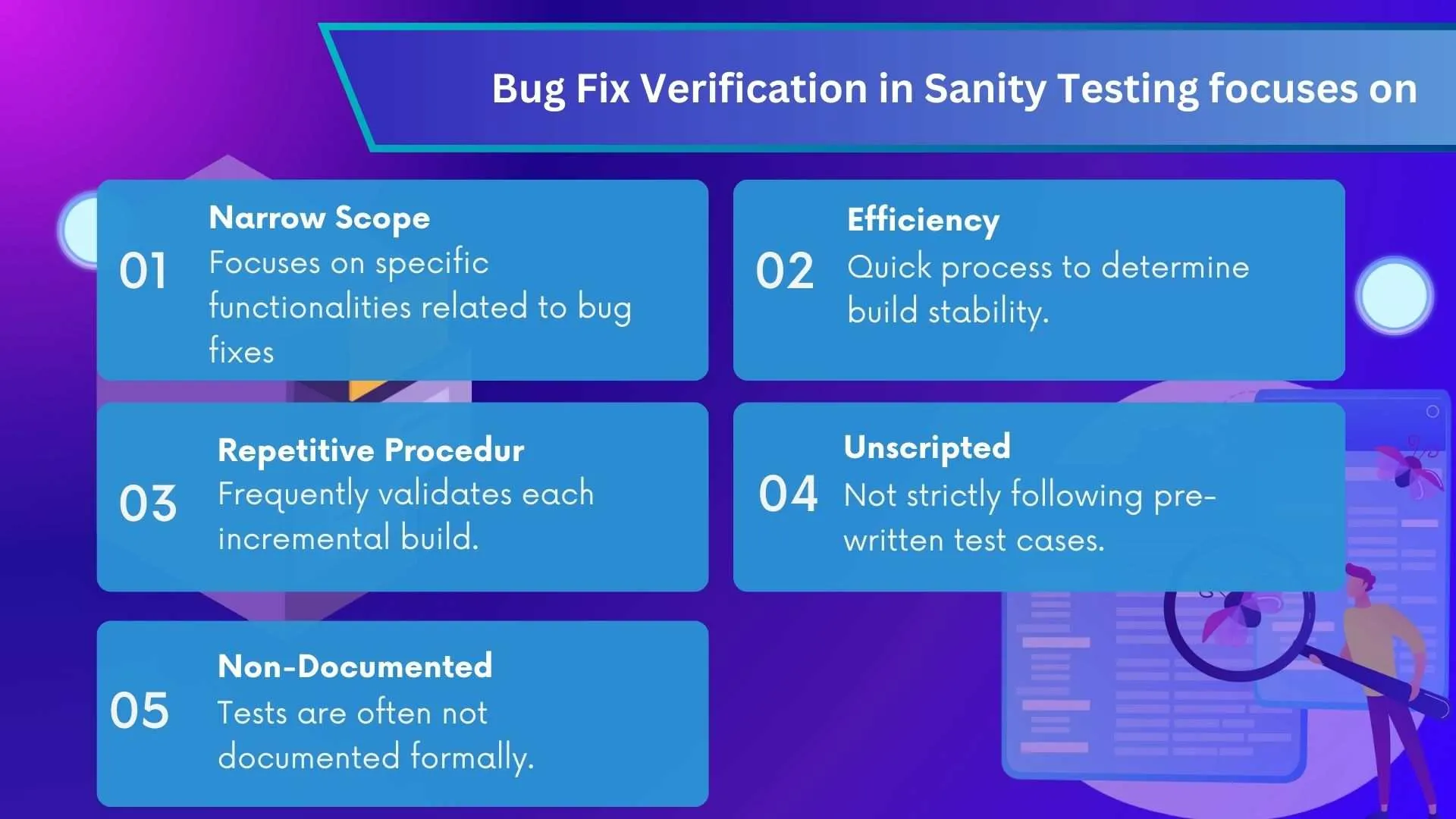
Key Elements of Sanity Testing
Sanity Testing involves the following key elements:
- Focused Testing🎯: Concentrates on specific areas affected by recent changes.
- Quick Execution⚡: Designed to be executed quickly to provide immediate feedback.
- Selective Testing🔍: This does not cover the entire application, only the relevant parts.
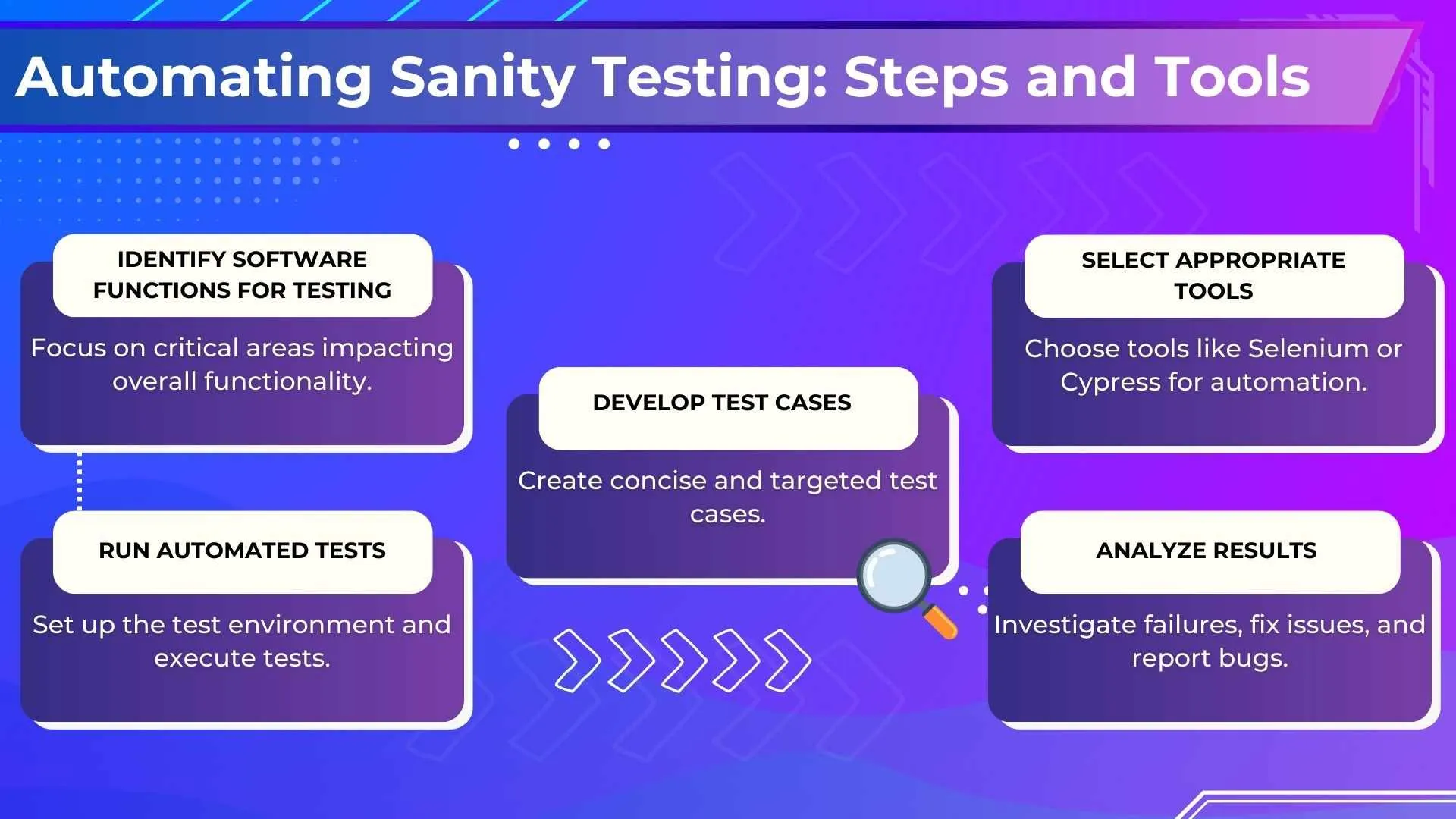
The Process of Sanity Testing
The process of Sanity Testing typically involves:
- Identify Affected Areas🛠️: Determine which parts of the application are impacted by recent changes.
- Select Test Cases📋: Choose relevant test cases that cover these areas.
- Execute Test Cases🚀: Run the selected test cases.
- Analyze Results🔍: Ensure the changes work correctly and do not introduce new issues.

The Typical Entry Criteria for Sanity Testing
The entry criteria for Sanity Testing ensure that the software build is ready and suitable for this type of testing. Common criteria include:
- Stable Software Build 🏗️: Received after minor changes or bug fixes.
- Bug Fixes and Code Changes 🛠️: Recent fixes and pieces of code changes need verification.
- Crucial Functionality 🌟: Identified and ready for testing.
- Test Environment 🖥️: Properly set up and configured.
- Test Cases 📋: Relevant subset prepared and prioritized.
- Regression Testing 🔄: Often follows regression testing if it results in bug fixes.
Sanity Testing consists of conducting basic tests through a built-in test runner to validate the test suite. The Primary Objective 🎯 is to validate the application features. This process helps assess business risk 📉 and ensures the baseline level 📊 of functionality. It's important to test software after updates.

Key Differences Between Smoke Testing and Sanity Testing
It's important to know the difference between Smoke Testing and Sanity Testing for good software quality assurance🛡️. Testing is essential for the software development lifecycle, whether done manually or automatically. 🖥️
Below is a comparison table that highlights the key differences between Smoke Testing and Sanity Testing, focusing on their application within a software application:
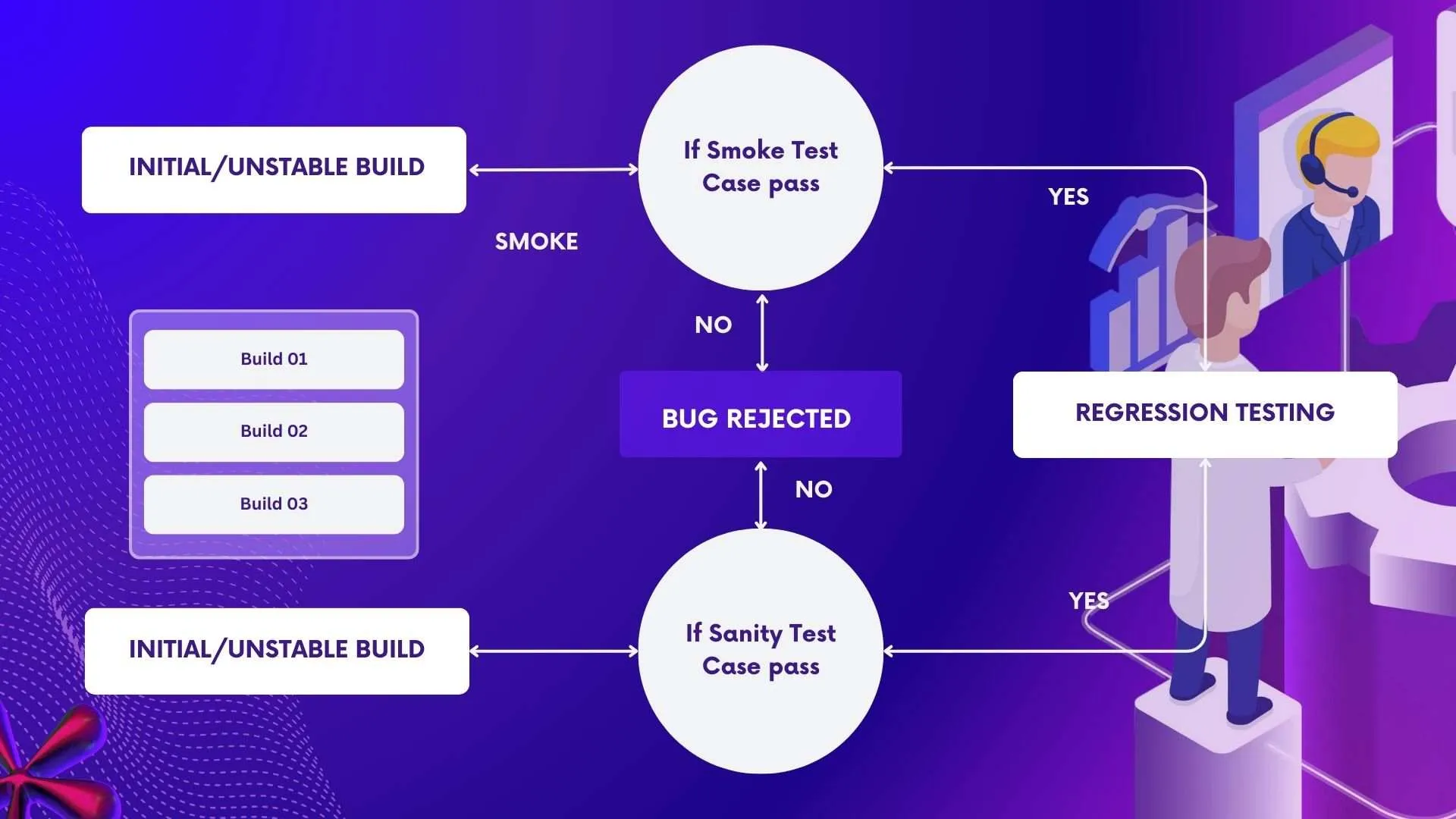
In Short!!
Knowing the difference between Smoke Testing and Sanity Testing can help teams improve their testing strategies for more reliable applications before deployment. Smoke Testing focuses on verifying the basic functionality 🔧 and stability of an application, while Sanity Testing validates specific functionalities 🎯 after minor changes or bug fixes.
Smoke Testing is often done by developers or testers and can be automated 🤖. Sanity Testing is usually manual, primarily done by testers, but can also be automated. Smoke Testing focuses on overall stability and functionality, while Sanity Testing validates specific changes. Understanding these differences ensures comprehensive testing for better software quality.
People Also Ask
👉🏻 Why Does Regression Testing Include Sanity Testing as a Subset?
Regression testing ensures that recent changes haven't messed up the existing functions. Sanity testing checks specific areas affected by changes after regression testing. It gives a quick preview before testing.
👉🏻 Are There Any Specific Risks Associated with Skipping Sanity Testing or Smoke Testing?
Yes, skipping these tests can lead to significant risks:
- Skipping Smoke Testing: This might result in undetected major issues, causing further testing to be futile.
- Skipping Sanity Testing: This can lead to specific defects being missed, which may cause functionality failures in production.
👉🏻 Which Comes First, Sanity or Smoke Testing?
Smoke Testing is typically performed first to ensure the overall stability of a build. Once the build passes Smoke Testing, Sanity Testing can be conducted to verify specific functionalities after changes.
👉🏻 Does Regression Testing Take Place After Sanity Testing?
Yes, regression testing is usually performed after Sanity Testing to ensure that recent changes have not impacted the existing functionalities of the application.
👉🏻 Are Sanity Testing and Smoke Testing Interchangeable Terms?
No, Sanity Testing and Smoke Testing are not interchangeable. They serve different purposes and are conducted at different stages of the testing process.





%201.webp)

